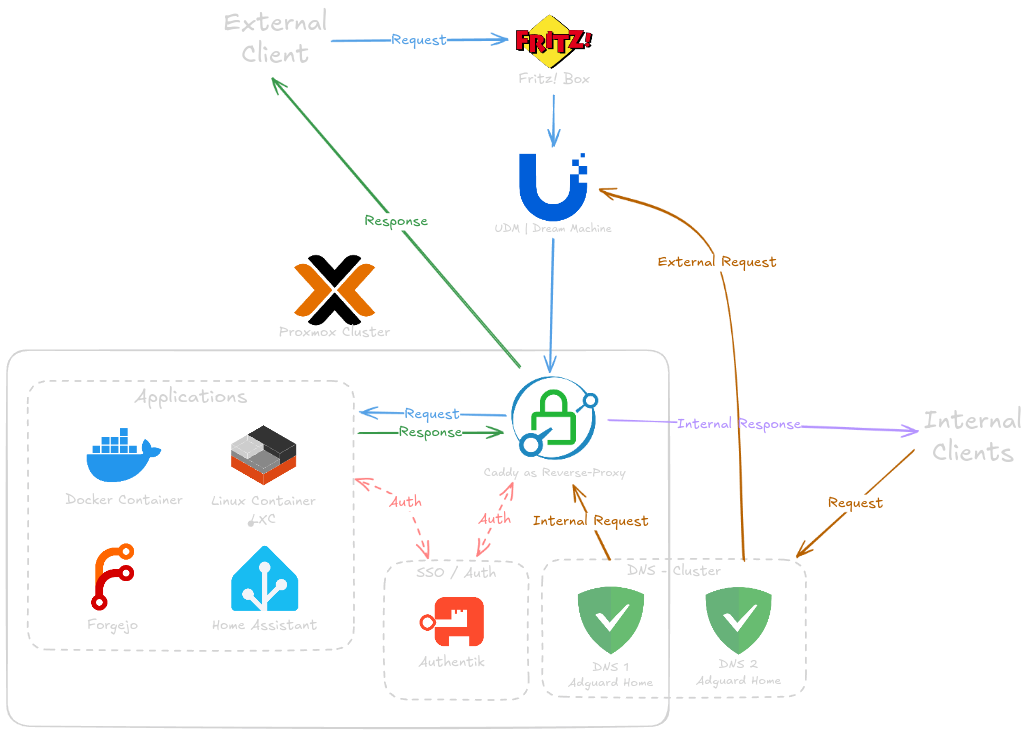HomeLab Setup
Basics
Maintaining a HomeLab can be a rewarding, but time‑consuming hobby - especially once the number of services, containers and virtual machines starts to grow. Early on I found myself repeating the same manual setup steps on every new host and constantly tweaking configuration files directly on production machines. That’s when I decided to embrace Infrastructure as Code (IaC) and let Ansible handle the heavy lifting for me.
Here is a image that should explain the basic setup for my HomeLab:

I recently switched from a basic port forwarding solution to pangolin as my self hosted tunnel/proxy provider.
The Repo
You can browse the entire setup here -> Ferdyverse/HomeLab on Github
The repository is organised like this (simplified):
HomeLab/
├── group_vars/
│ ├── all/
│ └── proxmox_nodes/
├── handlers/
├── inventorys/ # inventory files (yes, the repo spells it this way)
├── roles/
│ ├── adguard_home/
│ ├── caddy/
│ ├── grafana/
│ ├── ntfy/
│ ├── pve/
│ ├── semaphore/
│ └── ... (other service roles)
├── tasks/
├── templates/
├── ansible.cfg
├── container_configure.yml
├── container_create.yml
├── nodes_configure.yml
├── requirements.yml # Ansible Galaxy collections
├── requirements.txt # Python dependencies
└── setup_environment.sh
Settings
Below are some defaults I rely on throughout the lab. Sticking to a convention means every new service knows exactly where to mount volumes and look for its configuration.
Docker
For my docker setup I currently use many lxc containers. I thought about switching to Docker Swarm, but I do not see any benefits for my setup because I only have 2 Proxmox nodes.
On each of my docker nodes I have the following storage setup:
| Path | Purpose |
|---|---|
/home/{{ default_user }}/docker |
Docker Compose files – One folder per stack or service. |
/docker |
Configuration files – Static configs such as traefik.yml, grafana.ini, promtail.yml, … |
/data |
Persistent data – Bind mounts for databases, Prometheus TSDB, MinIO buckets, etc. |
Note 📝 All directories are created and owned by UID
1000(the primary unprivileged user on my nodes). This avoids permission headaches when containers drop root privileges.
Secrets
For my secret management I use 1Password with a special HomeLab-Vault. I recently discovered the possibility to use the 1Password-Connect Stack to be able to use my secrets via a REST-API in Ansible and other services. This stack consists out of two main components . The Connect-API and the Connect-Sync container.
services:
op-connect-api:
image: 1password/connect-api:latest
restart: unless-stopped
volumes:
- '{{ docker_container_data_folder }}/onepassword/data:/home/opuser/.op/data'
- './token.json:/home/opuser/.op/1password-credentials.json'
ports:
- 8085:8080
op-connect-sync:
image: 1password/connect-sync:latest
restart: unless-stopped
volumes:
- '{{ docker_container_data_folder }}/onepassword/data:/home/opuser/.op/data'
- './token.json:/home/opuser/.op/1password-credentials.json'
CI/CD
I mainly use a Forgejo runner for my pipelines. There I configured a pipeline called autoupdate.
The autoupdate pipeline runs automatically on each push and checks for certain file changes. Based on the found changes it updates some of my HomeLab services.
name: update-homelab-services
on:
push:
branches: [ main ]
paths:
- '**/roles/glance/files/**'
- '**/roles/glance/templates/**'
- '**/roles/caddy/vars/main.yml'
- '**/roles/caddy/templates/**'
- '**/roles/ntfy/defaults/main.yml'
- '**/roles/pve/vars/main.yml'
workflow_dispatch:
inputs:
service:
description: 'Service to update'
required: false
default: auto
type: choice
options: [auto, caddy, glance, ntfy, pve, all]
jobs:
update:
runs-on: ubuntu-ansible
container:
env:
ANSIBLE_STRATEGY: serverscom.mitogen.mitogen_linear
OP_CONNECT_HOST: ${{ vars.OP_CONNECT_HOST }}
OP_CONNECT_TOKEN: ${{ secrets.OP_CONNECT_TOKEN }}
steps:
- name: Checkout latest version
uses: actions/checkout@v4
- name: Filter changed files
id: filter
uses: https://github.com/dorny/paths-filter@v3
with:
filters: |
glance:
- 'roles/glance/files/**'
- 'roles/glance/templates/**'
caddy:
- 'roles/caddy/vars/main.yml'
- 'roles/caddy/templates/**'
ntfy:
- 'roles/ntfy/defaults/main.yml'
pve:
- 'roles/pve/vars/main.yml'
- name: Prepare Ansible
run: ansible-galaxy install -r requirements.yml
- name: Update Glance Pages
if: |
(steps.filter.outputs.glance == 'true' && github.event_name != 'workflow_dispatch') ||
(github.event_name == 'workflow_dispatch' &&
(github.event.inputs.service == 'glance' ||
github.event.inputs.service == 'all'))
run: >
ansible-playbook -i inventorys
--limit glance
--skip-tags user,lxc_config.ssh,glance.setup
container_configure.yml
- name: Update Caddy vhosts
if: |
(steps.filter.outputs.caddy == 'true' && github.event_name != 'workflow_dispatch') ||
(github.event_name == 'workflow_dispatch' &&
(github.event.inputs.service == 'caddy' ||
github.event.inputs.service == 'all'))
run: >
ansible-playbook -i inventorys
--limit caddy
--skip-tags user,lxc_config.ssh,caddy.setup,caddy.alloy
container_configure.yml
- name: Update ntfy users
if: |
(steps.filter.outputs.ntfy == 'true' && github.event_name != 'workflow_dispatch') ||
(github.event_name == 'workflow_dispatch' &&
(github.event.inputs.service == 'ntfy' ||
github.event.inputs.service == 'all'))
run: >
ansible-playbook -i inventorys
--limit ntfy
--skip-tags user,lxc_config.ssh,ntfy.setup
container_configure.yml
- name: Create new container
if: |
(steps.filter.outputs.pve == 'true' && github.event_name != 'workflow_dispatch') ||
(github.event_name == 'workflow_dispatch' &&
(github.event.inputs.service == 'pve' ||
github.event.inputs.service == 'all'))
run: >
ansible-playbook -i inventorys
--skip-tags update_lxc
container_create.yml
- name: Send notification to Discord
uses: https://github.com/sarisia/actions-status-discord@v1
if: always()
with:
webhook: ${{ secrets.DISCORD_WEBHOOK }}
status: ${{ job.status }}
title: "Auto Update"
description: "Automatic HomeLab Updates"
url: "https://git.berger-em.net/bergefe/HomeLab"
username: Forgejo Actions
To run this pipeline I had to build my own docker container image. This image includes Ansible, NodeJS, 1Password-CLI and Mitogen. Here you can get the Dockerfile to create your own version.
Future
I am still working on this topic and I try to add more features. The goal for this project is to be able to maintain and update my HomeLab with a single Ansible-Playbook, In the best case, most of the tasks will run on its own and just send me some notification when something went wrong.